#The Frog King
Explore tagged Tumblr posts
Text
my love has gone into the well, and the water is lower now than it has ever been. i cannot touch him, anymore. in the dark and the damp, he is the same colour as the moss. when he calls, it is a choir.
something in my chest groans. something aches.
he cannot climb back up to me. his hands are not made for rough things, and his eyes have forgotten the brightness of the sun. if i cupped him in my palms, i would wick the moisture from his skin.
as a caught fish trying to push air through gills, as a rat trying to breathe water, i would surely kill him.
those fine bones and that wet skin would crack. this mouth would open wide. i couldn't put him back into the water until that small heart has stuttered. until that voice has given out.
it would be too late, then.
go, says my love from where the well holds him tight. you are relieved of your duty. you are relieved of your lord. go, and leave me to the water.
i go. something blooms under my skin. when i press my palms against my breast, i lose my breath. i go.
i wail.
there is a bruise above my heart, and it is darkening. its edges are yellow, and its center is a deep, hard purple. every breath digs into the rough pit where my love sits, watching the water sink into the earth.
the blacksmith cannot keep my heart from breaking. she cannot reach into the hollow of me and fuse the muscle as if it were metal, red-hot and screaming.
instead, she lays three iron bands about my chest, tightest where the bruise is darkest. if i hook a finger underneath them, my breath won't take. there are no locks. there are no keys.
my heart beats on, somehow.
#the frog king#iron henry#der eiserne heinrich#on love#and grief#and sorrow#in which a heart is held together by iron bands#writerblr#writers of tumblr#my work#spilled ink#spilled words#hi im having Feelings
127 notes
·
View notes
Text
When two completely unrelated fairy tale adaptations use the same name for a character, I feel tempted to think of that name as the character's "official" name.
For Cinderella's Prince, it's either "Christopher" or "Henry." Both the Faerie Tale Theatre adaptation and the movie Ever After use "Henry," while "Christopher" is used in every version of the Rodgers and Hammerstein musical, as well as the YA novel Mechanica, and presumably Disney's 2015 live action remake, since "Kit" is usually a nickname for "Christopher."
For the Frog Prince (the original fairy tale character, not Naveen from The Princess and the Frog, of course), it's "Robin", because both Faerie Tale Theatre and the Tales from Muppetland adaptations use that name. In both cases, it's the name of his actor (or Muppet "actor") – the late, great Robin Williams, and Kermit's little nephew Robin the Frog, respectively.
For the soldier in The Twelve Dancing Princesses, its "Peter." That name is used for him in both Marianna Meyer's picture book retelling and the Grimm's Fairy Tale Classics adaptation, and in the Faerie Tale Theatre adaptation, while he isn't named onscreen, he's played by actor Peter Weller.
@ariel-seagull-wings, @adarkrainbow, @themousefromfantasyland
#fairy tale#fairy tales#adaptations#character names#cinderella#the frog prince#the frog king#the twelve dancing princesses#the shoes that were danced to pieces
25 notes
·
View notes
Text
An important thing too many people are unaware of.
Disney's "The Princess and the Frog" is NOT based on the brothers Grimm's The Frog King, more commonly known in the English world as "The Frog Prince".
Or rather it is inspired by it, but in a secondary and distant way.
The ACTUAL source material and main inspiration behind the movie is a fairytale novel published in 2002, named "The Frog Princess" by E.D. Baker.
So if you see someone claim for example that "Disney invented the idea of the girl kissing the frog becoming a frog herself" you will know these people have NOT done their research - because it was present in Baker's novel, and formed the entire plot of it.
#the princess and the frog#disney's the princess and the frog#disney#the frog prince#the frog princess#the frog king#e.d. baker#disney fairytales
97 notes
·
View notes
Text
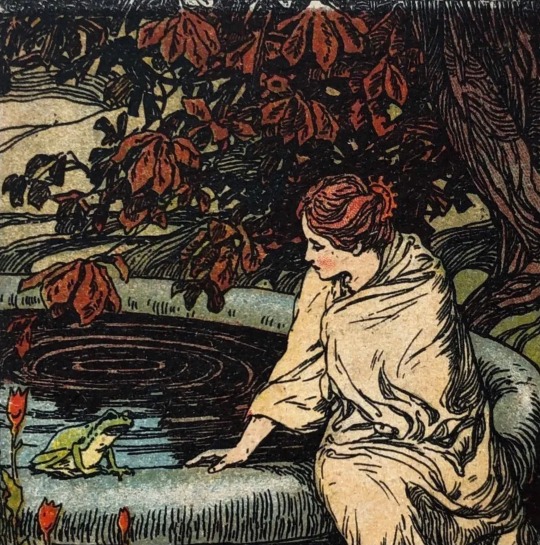
Gustav Weise’s Kinderbibliothek
Early 20th Century
Illustrator unknown
#gustav weise#märchen#märchenbuch#kinderbüch#children's literature#children's illustration#fairy tale#children's books#fairy story#vintage illustration#children's book#fairy tales#old illustration#fairy#old book#fairy stories#der froschkónig#le roi grenouille#the frog king#the frog prince#early 20th century#dornröschen#frog#princesse#grenouille#conte de fée
303 notes
·
View notes
Text
Let's look through some weird-ass fairytales.
Hi, I'm the Potato Pixie, and I like fairytales. One day, I'd like to make comic adaptations of some of the weirder ones, or some well-known ones but the original versions, cause those get weird as hell.

I'm specifically going off from this book, a Barnes and Noble exclusive edition that I got for Christmas in 2015, but the inside specifically lists this as the Margaret Hunts translation from 1884.
So, I'm going to tell you all the broad strokes of the story, any important details, provide my shitty commentary, and how it could possibly be adjusted to a short comic.
My goal is to, when I can, make the characters more human, or give them more character. When I do character designs, and I'll post those as well, give traits and characteristics that aren't conventionally attractive.
Anyways, we're starting with the Frog King!
It's the first one in the book, and I'm interested in adapting it, so we'll go with that!
So it starts with the unnamed Princess tossing a gold ball, which is her favorite plaything, by a well.
Eventually, she tosses it and it falls in the well, and it's so deep she can't see the bottom or her ball.
She cries so much that the stones would show pity, (or maybe she thinks they would, this version very much has spoiled brat vibes) that soon a talking frog comes out of the well and asks her what's wrong. The princess though disgusted at the talking Frog, tells him about the ball, and he offers to get it for her, if she agrees to take the Frog back to her castle, and let the Frog eat with her, play with her and sleep in her bed with her.
The Princess fully intending to ditch the Frog agrees, and as she gets her ball she runs off, and frog croaking and yelling for her
At the castle, the Princess and the King are eating until they hear a knock at the door, and the king questions whoever it could be as the princess is freaked out knowing it's the Frog, and after said Frog asks her if she doesn't remember the agreement they had, the King tells the Princess that she has to keep her promise, and she begrudgingly picks thr Frog up and takes him to the table, to which he seemingly eats off her plate with ease, and she choking down every bite. (Like man that'd gross me out too, the princess is kinda a bitch but like, same)
Eventually, the Frog decides he's full and wants to go to sleep, and the Princess carries the Frog with two fingers by his leg up the stairs. When the Frog insists upon being carried up onto her bed, she gets so angry she takes the Frog and THROWS HIM AGAINST THE WALL.
Nah, no romance, no character development of like a spoiled brat learning to be nice, fucking YEETS the slimy bitch to the wall.
The weirdest part is, THATS WHAT TURNS HIM BACK INTO A PRINCE??? I have the whole scene planned in my head, bitch goes splat, slides down, the bottom half of the shot is like covered by the bed in the foreground and there's like a delayed POOF and then his gets up as a human holding his head.
Anyways, the Frog King (we're still gonna call him Frog) tells the Princess that a witch had cast a spell onto him and no one but her had taken him from the well (So I guess it was the well that was keeping him a frog?? But the Princess didn't do shit, she ran off!! So idk)
And then in the morning as mentioned, a carriage of white horses rolls up, and weirdly the only Named character, the servant Faithful Henry is said that he was so unhappy that his master was turned into a Frog, that three iron bands were laid upon his heart, lest it should burst from sadness.
They get in the carriage, and the Kings son (so like, it's not mentioned at all before that the Frog King has a son, neither the princesses father, and only the princess and the Frog King are described to get in the carriage. They mention that because the Princess agrees to be the Frogs companion and playmate, and that by her fathers will is now her husband, so where did the son come from? They go to the kingdom the next morning, so idk)
The Son thinks the carriage is breaking, but Faithful Henry says it's only the bands upon his heart bursting with joy and happiness that his master has returned.
The End
And that's it!! It's so weird, but I kinda like the lack of romance. And the Princess fucking Yeeting the Frog is great lmao
Also the servant Henry is giving Forbidden Lover vibes? Like how the hell is this dude THAT HAPPY that King is back? And what's up with the random Kings Son??
How do we Adapt this?
So keeping as much elements from the original tale as possible, here's what I got.
The Princess is spoiled, maybe she's got texture issues so she hates slimy things? Eh maybe not, but I am getting "POV The Girl You Think Is Mean Is Really Just A Girls Girl kinda vibes? Maybe I've just been watching thise too much.
Anyways, I'm thinking, take out the Kings son at the end, cause he serves no purpose and only shows up at the tail end, and Princess becomes the Fake Wife of the Frog King so he can be with his servant lover and the Princess can live on splendor or some shit.
#fairytale#fairytales#grimms' fairy tales#grimm#the brothers grimm#the Frog King#Frog#princess and the frog#book adaptation#comic#comic books#idk#adaptation#rant#story#storytelling
5 notes
·
View notes
Text
KERMIT FACTS
kermit hit me :((((
31 notes
·
View notes
Text
He had not regretted turning down her proposal, not even while he was still a frog, but he should not have spoken to her so scornfully. He ought to have known better than to be impolite to a witch.
But he had too quick a temper, and her advances had surprised him most unpleasantly. He had had no thought of marrying at that time, why should he have? His life was perfectly comfortable.
The witch's temper was as quick as his own, however, and she had not taken kindly to his refusal.
The young king glanced at his looking glass. They still called him the Frog King, and part of him still expected to see an inhuman face looking back at him…
Seven more days to the wedding. Seven days and eight nights until he could call his beloved princess his wife. There was nothing left of his disdain for marriage now. He was well aware what a joke that was on him. He deserved to be ridiculed for it. But he had never met such a woman before! The way she spoke to him- No one at the entire court, no one in the entire kingdom spoke to him like that. It was as if she saw right through him. She hadn’t put up with any of his amphibian rudeness and she wouldn't put up with any royal misbehaviour either.
And yet she loved him.
That was the one, most wondrous thing about her. That she would come to know him like a demanding, bartering frog, that she would see through him like she did, and that despite all this, she could still love him. Love him enough to liken his faults to her own, to make light of them, and to consent to become not just his Queen, but his wife.
No one else would even have entertained the thought.
#still have frog king on the brain#this is linked to the Iron Heinrich drabble of course#but this is my blog and I delight in just chucking things out here for who wants them#there is more of this#and I will put everything neatly in one place later#but for now: /devotion/#laura drabbles#wlm romance#the frog king#the frog prince#the grimms never say /why/ the wicked witch turned the king into a frog#so I borrowed the marriage refusal from the old beauty and the beast
81 notes
·
View notes
Text
Friendship - The Frog Prince
youtube
@professorlehnsherr-almashy
8 notes
·
View notes
Text

"The Frog King or Iron Henry", by the Brothers Grimm.
"Now it happened one day that the golden ball, instead of falling back into the maiden's little hand which had sent it aloft, dropped to the ground near the edge of the well and rolled in. The king's daughter followed it with her eyes as it sank, but the well was deep, so deep that the bottom could not be seen.", from The Frog King.
"So she picked up the frog with her finger and thumb, carried him upstairs and put him in a corner, and when she had lain down to sleep, he came creeping up, saying 'I am tired and want sleep as much as you; take me up, or I will tell your father.' Then she felt beside herself with rage, and picking him up, she threw him with all her strength against the wall, crying: 'Now will you be quiet, you horrid frog!'", from The Frog King.
#the frog king#iron henry#brothers grimm#fairy tales#fairytale#folk tales#reading#moodboard#aesthetic
2 notes
·
View notes
Text
Forever thinking about the nonsensical nature of The Frog King/The Princess And The Frog.
Imagine for a moment: you're forced to wine and dine a literal frog because you promised, but you absolutely put your foot down about letting the frog into your bed and instead throw said frog at a wall; and for some unfathomable unexplained by the narrative reason, that's what it takes to break this curse on the frog.
What exactly is this curse? You shall be cursed to be a frog forever, lest you find a lady true and fair who will wine and dine you but not let you into her bed? Like, is it about virtue or something? And, if this whole thing is about virtue, what does that mean for why the king was turned into a frog in the first place? What did he do??? What was the reason???????
And that, of course, this is all presuming the curse is in fact about virtue at all. What if it isn't? What then?
I have so many questions. I think about this constantly.
#the frog king#the princess and the frog#fairytales#words from alice#text#y'all can reblog this if you want
5 notes
·
View notes
Text
The Frog King: Toxic Relationships and Open Heart Surgery
youtube
2 notes
·
View notes
Text



The Frog King
#amphibian royalty#the frog king#frog prince#my work#plushies#small business#art#handmade stuffed animal#art doll#i made this#periwinkle plush#plush art#plush artist
4 notes
·
View notes
Text
Being half-Jewish, I can't help but smirk at the fact that in the original German text of The Frog Prince (or The Frog King), the Princess's golden ball is referred to as a "goldene Kugel."
Of course "Kugel" just means "ball" in German. The name of the classic Ashkenazi Jewish pudding comes from the fact that it was originally a round pudding boiled or steamed in a cloth. Only later did it come to be baked in a square pan instead.
Still, when your introduction to the word "kugel" was the food, it creates the silly mental image of the Princess playing with a baked pudding sculpted out of gold.
#the frog prince#the frog king#fairy tale#the brothers grimm#german language#kugel#judaism#food#silliness
15 notes
·
View notes
Text
Some scholarly notes about the Grimm fairytales (2)
A follow-up of this post.

The Frog King or Iron Henry (Der Froschkönig oder der eiserne Heinrich)
This story belongs to the AaTh 440, "The frog-king".
The story first appears in the 1810's manuscript, written by Wilhelm - it was probably told by Henriette Dorothea "Dortchen", Wilhelm's future wife. A second version, called "The frog prince", had been told to them by their friend Marie Hassenpflug and was published in the 1815 edition as the thirteenth tale, before being moved to the notes of the 1822 due to its too-great similarity with the KHM 1.
This fairytale was originally called "The king's daughter and the bewitched prince". The 1810 manuscript has, written by Jacob right next to the title, "The frog-king", while the paper on which he had placed all his notes about the fairytale bore the name "Iron Henry". The evolution of this fairytale is very interesting because it testifies the brothers' love and care for details, hich had the story double in sie throughout the editions. In the final text we have, for example, a long sentence describing how the princess sees the ball fall into a well so deep she can't see the end, and about her crying a lot and lamenting, etc, etc... In the 1810 manuscript it was just one short sentence "She stood near the well and she was sad."
The major editing of this tale was the removal of the erotic motif from the tale's ending. Originally, the frog asked the princess the authorizaton to sleep in her bed, and right after the frog became a human it was written "the princess joined the prince in bed". This, plus the addition by the Grimms of moral lessons delivered by the father (the king tells things such as "You must always keep your promise" and "You must not disdain the one who helps you"), completely changed the goal and purpose of the tale - it was originally about setting free an animal husband, but the Grimms turned it into a moral tale to learn a virtuous behavior.
The brothers Grimm considered this fairytale to be the oldest and most beautiful of their collection. Allusions to the frog-king tale can be found as early as the Middle-Ages and the 16th century. In the 1801 edtion of the 1548 Scottish book "Complaynt of Scotland", a note evokes how a tale is similar to "The Frog Prince" due to having a well, the presence of magic, and a frog complaining in rhymes. In this Scottish version, a girl is sent by her stepmother to fetch water at "the well of the world's end". There she meets the frog, who tells her it will offer her water only if she agrees to marry it - if not, the frog will rip the girl apart. The brothers Grimm themselves noted various literary sources for their tale, that they used in their compilation work. The name of Henry (Heinrich) comes from the novel "Der arme Heinrich" by Hartmann von Aue. They also listed the "Froschmeuseler", a didactic epic by Georg Rollenhagen depicting a war between frogs and mice: the association of sadness with "rings of iron" comes from this text, as well as the very name "frog-kng" which is found in the title of the second chapter "Tale of the encounter between Thief-of-Crumbs, son of the mice-king, with the frog-king".
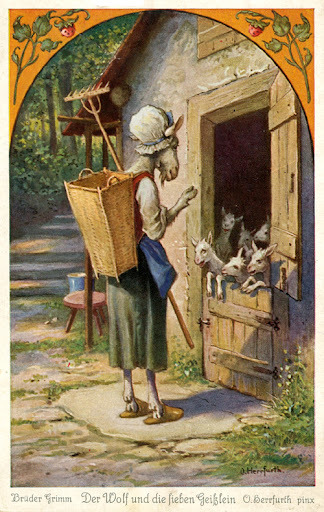
The Wolf and the Seven young Goats (Der Wolf und die sieben jungen Geiblein)
It is the AaTh 123, "The wolf and the lambs".
Collected in the "region of Main" according to the Grimm, it is very likely that the brothers Grimm received this tale from someone of the Hassenpflug family, as they knew the French fables of La Fontaine which correspond to this fairytale. In the 5th edition of their book, the brothers Grimm modified their story due to the publication in 1842 of an Alsacian tale by Ströber, "Die sieben Gaislein", "The seven young goats" (collected in Volksbüchlein, "The Folks' Small Book) - Wilhelm Grimm borrowed several expressions from this text. The brothers Grimm listed this Alsacian tale in their notes.
In their notes the brothers Grimm listed a Pomeranian version about a child who, when his mother is out, is swallowed by a sort of bogeyman known as "The children's ghost". But since the ghost eats stone at the same time, he becomes slow and heavy - he falls and the child can escape his belly unharmed. The brothers Grimm also listed variations collected/written by Boner in his Edelstein, and by Buckhard Waldis - as well as the La Fontaine fables. They also knew of a French fairytale, from which they noted a passage where the wolf asks a miller to turn her paw white with flour, and since the miller refuses, the wolf threatens to eat him. The Grimms linked the episode of the wolf's belly filled with stones with the legend of a Nereid called Psamathe, who sent a wolf destroy the flocks of Peleas and Telamon, only for the wolf to be petrified.
This tale, like many others within the Grimm's collection (it is especially comparable "Cat and Mouse in Partnership) is aimed at educating young children, with the narrator highlighting how children should be wary and distrustful of the wickedness and cowardice of men. Unlike other versions and predecessors of the tale, the brothers Grimm insist on the mother's role as a teacher, and on the fact that she saves her kids.

Rapunzel
It is the AaTh 310, "The maiden in the tower".
The literary sources of this fairytale are well-known. It was preceeded by the French literary tale "Persinette", by mademoiselle de La Force, itself inspired by Basile's story "Parsley Flower". In their notes the brothers Grimm explained they took inspiration from the almost-literal German translation of mademoiselle de La Force's story by Friedrich Schulz. However, in quite a misunderstanding, the brothers admired this tale as being an obvious "folktale" coming from the "oral tradition" - when we know it was a literary fairytale, though based on a folkloric motif.
The text was heavily edited after the many criticism the first edition of the book underwent - the scene depicting the prince's relationship with Rapunzel was regularly changed. In 1837 it is written that the prince asked Rapunzel to marry him almost right away, and she agreed since he was young and pretty, and they "held hands". In 1819, it was written that they lived together in "joy and pleasure" for a certain time, and "loved each other like woman and wife", and the "fairy" only realizes something is up when Rapunzel blurts out it is easier to make the prince climb than her "godmother". In the 1812 edition, it is said that Rapunzel and prince lived together in "joy and pleasure", but no mention of any marital couple whatsoever - and Rapunzel betrays her condition to the "sorceress" because she complains about her clothes getting too tight.
The Grimm noted that many versions of the "girl in the tower" fairytale existed, but with a different opening relying on the "forbidden room" motif: the witch punished the girl by locking her up in a tower because she had opened a door the witch explicitely forbade her to. The Grimm also listed several stories (outside of Basile's version) where a mother (sometimes a father) bargains their future child to satisfy a temporary craving - such as the Nordic "Alfkongs-Saga", where Odin offers Signy's wish for the better bear in the world in exchange of what is "between her and the barrel", aka the child she bears. In a book of Büsching we find a girl named "Petersilie" (Parsley in German) which loves eating prasley more than anything in the world and brushes her long hair by a window. The idea of using hair as a rope or ladder, long before Basile used it, seems first recorded by from the "Book of the Kings" of the poet of Persia Firdoussi, in the 10th century: the hero, Zal, joins the beautiful Roudebeh by climbing up her braids.
The name the sorceress wears in the German tale, "Frau Gothel", had been explained by the Grimm in such a way: "The godfather is not only called Vater (father) but also Pathe (godfather/"parrain" in French), or Goth or Dod ; the baptized child is also called "Pathe" or "Gothel", hence the confusion of the two within the legend". So, the dominating hypothesis (which seems confirmed by the variations of the fairytale) is that "Gothel" means "godmother".
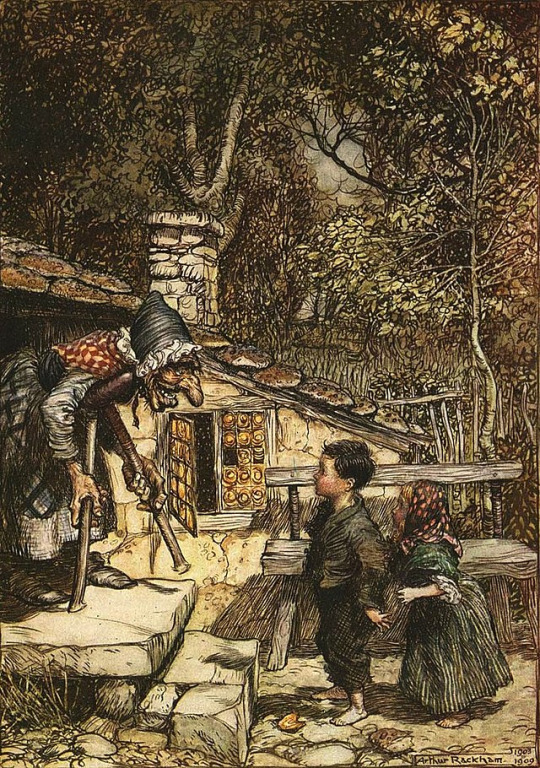
Hansel and Gretel (Hänsel und Gretel)
It is of course the AaTh 327 A, "Hänsel and Gretel" (a subtype of "The children and the ogre"). It also covers the AaTh 1121, "Burning the witch in her own oven".
In the 1810 manuscript this fairytale was called "Little brother and Little sister", a name that would later be reused by another famous Grimm fairytale (KHM 11). It seems that one of the reasons for the Grimm's big edits on this tale was the publication in 1842 of the Alsacian version of this story by August Stöber, "The little house of pancakes" (Das Eierkuchenhäuslein) - which itself was inspired by the Grimm's original publication of "Hansel and Gretel" (full loop here). Wilhelm Grimm notably borrowed several turn of phrases from Stöber.
The motif of the children abandoned in the woods can be found back in Basile's Nennillo and Nennella, though the extension to the encounter of a child-eating monster is rather present within Perrault's Petit Poucet and madame d'Aulnoy's Finette Cendron (both also contain the motif of the treasures inside the ogre's house). While we know the Grimms were aware of Perrault's story, we also know that madame d'Aulnoy's fairytales, including "Cunning Cinders" had been brought to Germany by ther adaptation for the German branch of the "Bibliothèque Bleue" - Blaue Bibliothek. Ludwig Bechstein's own version of "Hansel and Gretel" was very famous - and he actually wrote it inspired by the German translation of Stöber's own tale.
The motif of ashes, crumbs or seeds left behind to tell the way is recurring within the brothers Grimm fairytales: it also appears on the KHM 40 (The Robber Bridegroom) and 169 (The Hut in the Forest), as well as in their first "Legend for children". This motif can be found back in German literature to 1559's Gartengesellschaft (The company within the garden) by Martin Montanus, where it appears in the tale "The small earth-cow", Das Erdkühlein.
It is recognized that this fairytale is the second most popular and famous Grimm fairytale right after Snow-White. It was heavily illustrated - first by none other than Ludwig Emil Grimm himself (another brother of the Grimms). As we said before, Bechstein's own fairytale was a strong "rival" to the Grimm's, and was illustrated by Ludwig Richter in 1853. The motif of the "bird leading to the Ohterworld" is found back in the KHM 123 (The Old Woman in the Wood), and in both cases the fact the bird is white indicates that it is an Otherworldy animal.
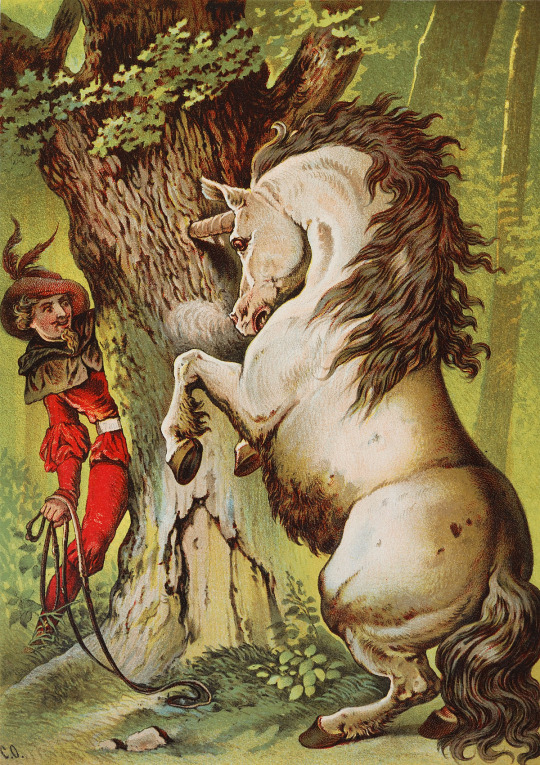
The Brave Little Tailor (Das tapfere Schneiderlein)
This fairytale belongs to many different Aa-Th types: 1640 (The brave little tailor), 1051-1052 "Curb, cut and move a tree", 1060-1062 (Throwing-stone conquest), 1115 (Attempt to kill the hero in his bed).
The 1810 manuscript began with this tale as its opening, probably as an homage to Brentano, since Wilhelm Grimm found this tale within his library, in a book called "Wegkürtzer", by Martin Montanus.
Among the modifications of the 2nd edition, a very interesting one is the addition of a sentence closing the first paragraph "and his heart moved with joy like the tail of a small lamb". This sentence comes from a novel by Christian Weise calle "The three most mad madmen in the whole world/The three most foolish fools in the whole wide world" (1762). Wilhelm Grimm explained this, as well as several other similar "borrowings", in the preface of the sixth edition, as his desire to insert in his tales specific sentences and expressions he knew to be typically German.
The brothers Grimm notd that Montanus' Wegkürtzer was frequently alluded to within the Renaissance literature and the baroque one - for example, when Johann Fischart translated in German Rabelais' Gargantua he inserted the sentence "I will kill all these flies, nine at once, like this tailor once did." It was also evoked in the "Simplicissimus" of Grimmelshausen, but references to the Little Tailor story go back to the Middle-Ages. The episode of a giant crushing a stone until water comes out of it is found in "Brother Werner", from the Codex Manesse (which compiled German Minnesang, courtly poetry) ; and Heinrich von Freiberg's Tristan describes at one point the hero crushing a cheese until juice comes out of it. Montanus' text was also used by Ludwig Bechstein in his book of German fairytales. One can compare the story of the Grimms to Tabart's "Jack the giant-killer" and Afanassiev's "Foma Berennikov".
The measurements in this story make no sense at all. The tailor buys four half-ounces of marmelade. Given an ounce was roughly 32 gr, the tailor bought 60 gr roughly... Not a quarter of a pound, as he claims. The reason for this incoherence is because, before 1854, a "pound" varied depending on which area of Germany you were into (it was 467 gr in Berlin, 510 in Nuremberg). It was only in 1854 that the value of the pound was unified in Germany, at 500 gr. Finally we note the presence at the end of the tale of the common European belief n the "Wild Hunt".
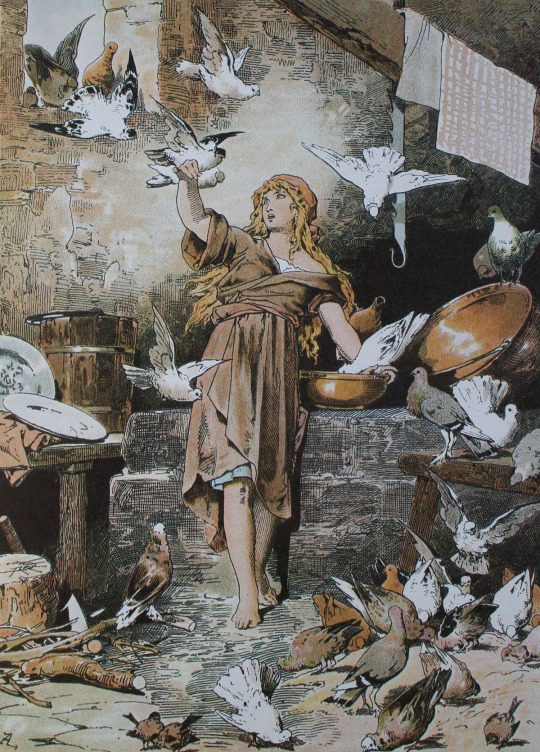
Cinderella (Aschenputtel)
Of course, it is the Aa-Th 510A, "Cinderella".
As early as the first edition, this fairytale was a mix of several variations. In their notes, the brothers listed nine different versions of the tale. One of them is quite fascinating: the opening scene of the mother's death and her promises of help is missing, the story begins immediately on the heroine's misfortunes. The end of the version also greatly differs and enters the domain of the KHM 11 "Little-brother, Little-sister". Soon after his wedding with Cinderella, the prince forbids her to enter a specific room of the castle - but encouraged by her sister, she opens the room when the prince is absent. It contains a fountain of blood that Cinderella's sister uses for an evil use: after the queen gives birth to her first child, her sister throws her in the fountain and replaces her in the bed. But the guards of the castle hear the moans of Cinderella, rescue her and the wicked sister is punished. Another version, from Mecklembourg, has an ending which makes the tale close to the legend of saint Genevieve of Brabant: Cinderella's stepmother and stepsister steal away Cinderella's two first children and replace them with animals ; the third time she gives birth, they order the gardener to kill the queen and her child, but he rather hides them in a grotto in the woods, where the child is fed by a doe. One day the child, old enough, goes to the castle to speak to his father, revealing to him the fate of his mother.
Another version, this time from Paderborn, begins in a way very similar to "Snow-White": a queen wishes to have a child as red as a rose and as white as snow. She gets her wish, but then her servant pushes her outside of the window, to replace her as the king's wife. The usurper gives birth to two daughters, and from then on we return to the classical Cinderella tale - her dead mother helping her from beyond the grave by offering her a key, opening a hollow tree where Cnderella finds what she needs to wash herself and dress up pretty for the church (plus a prayer book). Büsching evoked the existence of another version in the Zittau area, where Cinderella is a miller's daughter that is forbidden to go to church, and where it is a dog that denounces the false fiancée. Outside of all these oral sources, the brothers Grimm took inspiration, of course, from Charles Perrault's Cinderella, as well as from the first German literary record of the Cinderella story, "Laskopal and Miliwka", published in an anonymous collection of legends in 1808 (Sagen der böhmischen Voreit aus einigen Gegenden alter Schlösser und Dörfer").
From the second edition onward, the brothers Grimm heavily edited the story. They removed all the words and passages that referenced too much Perrault's version, replacing them by elements taken specifically from the three versions they collected in Hesse (such as the demand for a branch of a nut-tree, and the motif of the tree growing on the grave). In the 1812 edition, it was Cinderella's own mother who advised her daughter to plant a tree on her grave, and who predicted that this tree will help her in the future. Throughout the rewrites, Wilhelm Grimm heavily insisted upon the heroine's virtues, accentuating them so that they would fit the feminine bourgeois ideal of the time.
The first European record of this tale is Basile's "The cat of the ashes", and other famous literary versions include Perrault's Cinderella, madame d'Aulnoy's Cunning Cinders, as well as Ludwig Bechstein's Aschenbrödel. These versions were massively spread throughout Europe, notably due to the "peddling literature", the cheap books sold by peddlers: they helped the "Cinderella" fairytale type becoming as popular as it is today, and it seems very likely they influenced all the versions of the tale that came after them.
In their notes, the brothers Grimm explicitely compared the motif of the shoe in Cinderella with the legend of Rhodopis, who had her shoe stolen by an eagle, and the pharaoh that found it had her owner searched throughout Egypt. However the motif of the animals helping a persecuted heroine (especially when it comes to splitting grains) is very common, and has been popularized by the Roman tale of "Cupid and Psyche".
This fairytale is closely tie to the KHM 130, "One-Eye, Two-Eyes and Three-Eyes", both sharing the idea of a young girl humiliated by her sisters, and who obtains a social ascension as a form of compensation. A. B. Rooth studied the evolution of the Cinderella fairytale-type, and its relation with other fairytale-types: they determined that it is very likely the "Cinderella" story was originally told as a sequel to the "One-Eye, Two-Eyes, Three-Eyes" story-type. Later, the second part of this story gained its own autonomy, and became the "Cinderella" we know today.
The sexual connotations within the motif of "trying on the shoe" has been repeatedly noted and analysed since the Grimms published their story. Jacob Grimm himself saw in this the remains of an archaic Germanic betrothing ritual. Heinz Rölleke highlighted another cultural ritual that involved the future husband of a bride removing her old shoes before marrying her. The idea of the slippers tied to a wedding is also found within the KHM 133 (The Shoes that were danced to Pieces).
The name of the heroine in Germa, "Aschenputtel" designates a type of kitchen girl who searches throughout the ashes, and thus "rolls" herself in them - but it also means figuratively an insignifiant and a dirty girl. It seems to derivate from the greek "achylia", cinders/ashes, and "puttos", female genital organs. A combination echoed by the French name "Culcendron", "Ashen-butt". By extension, the name "Aschenputtel" can also designate the younger brother when he is disdained by his brothers and considered to be an idiot by his family: there is a lot of male Cinderellas in folktales, especially in Northern and Central Europe, but also in all German-speaking countries.
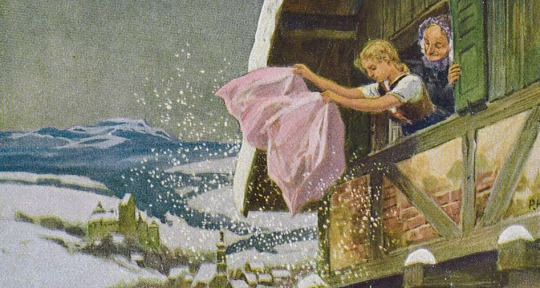
Frau Holle
Belongs to the AaTh 480 "The kind and unkind girls".
This story was told to Wilhelm Grimm by his future wife, Henrietta Dorothea Wild, who was then 18 years old. A secondary source was a tale told to their by the Hanovre pastor, Georg August Friedrich Goldmann - this second version contained the episode of the rooster saluting the girls. The second edition of the brothers Grimm's book added several details to this story to "rationalize" it - notably the Grimm added of their own an explanation as to why the girl jumps into the well.
This fairytale comes from Hesse and Westphalia. The brothers Grimm listed in their notes four other versions of it - and the first is more noticeable, because it echoes "Hansel and Gretel", as the house where the girls arrive is made of pancakes (crêpes). Older literary versions of "Frau Holle" can be found in Basile's Pentamerone (The Months, The Three Fairies), as well as within a French fairytale written by Gabrielle-Suzanne de Villeneuve, "Les nymphes" (The Nymphs). Translated in German in 1765, Villeneuve's fairytale notably inspired the Grimms when they composed their 1810 manuscript - they adapted her tale as their own story called "The marmot". Before the brothers Grimm, "ancestors" of "Frau Holle" can be found in various German fairytales, present in the collections of W. Reynitzsch (1802) and Benedikte Naubert (1789). Ludwig Bechsten did his own version of the fairytale (Gold-Mary and Pitch-Mary, Die Goldamaria und die Pechmaria) which had a huge success in Germany.
This fairytale belongs to a wide series of tales in which young girls leave their house to enter a far-away country which might be the Otherworld, and where they become the servants of a spernatural being. There, by performing tasks in a disinterested manner, they are rewarded. As with other fairytales, "Frau Holle" shows how the Otherworld and our world are inter-dependant with each other. "Frau Holle" had a huge mediatic success: it was adapted several times as movies, it is heavily present in children's literature, and it was heavily illustrated. The character of Frau Holle ("Holle" derivading from the Middle-High-German "hulde", "benvolent") is an ambiguous character, and shares several characteristic with Germanic water-spirits. She is a giver of supernatural gifts and goods, but she also punishes the wicked. This supernatural character is very present in German legends, especially in the oral tradition which associates her with the works of weaving and spinning. She might have her roots in the figure of a spirit in charge of women's initiation rituals.
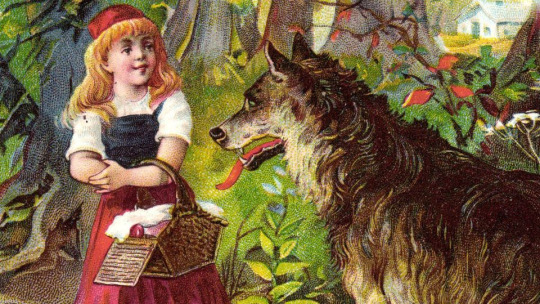
Little Red Riding Hood (Rotkäppchen)
It is of course the AaTh 333: "Little Red Riding Hood".
The two versions the brothers Grimm used to create this story were told to them by Johanna Isabella and Marie Hassenpflug. Isabella's version was most notable for being an obvious transposition of Charles Perrault's fairytales - with two elements changed. The tragic ending was modifed so that the girl and her grandmother would be saved ; and the erotic connotations of Perrault's fairytale (where the wolf was presented as a dangerous seducer) were removed.
Charles Perrault's fairytale was also present in German literature through Ludwig Tieck's verse tragedy "The life and death of little Red Riding Hood" (Leben und Tod des kleinen Rotkäppchens), published in 1800. As for Ludwig Bechstein, he inspired himself from the brothers Grimm tale to create his own "Little Red Riding Hood". M-L-Tenèze has worked on collecting all the oral and popular versions of Little Red Riding Hood in France, its birth-country, and has identified its original format as it must have been told before Perrault: usually they end like his tale in a tragic way for the girl, but rarely she notices she is in bed with a monster and manages to trick it to escape. However a detail Perrault erased and that is present in these versions is how the wolf keeps a bit of the grandmother's flesh and blood, that he offers to the little girl as food.
The first version of this story, in the original edition of the brothers Grimm book, was much more didactic than the one we have today, heavily insisting on how the little girl should have obeyed to her mother, and how there are specific ways to interact with strangers on the road - and in fact, it seems that the reason this fairytale was so popular and widespread was precisely because of its didactic nature. Because everybody knows the "original" version of the Grimm better than the final one, their second and revised text that shows a heroine able to learn from her mistakes, and ending up defeating the wolf of her own without any outside help. It should be noted that the first version of the Grimm tale had an echoing motif with the KHM 5 "The Wolf and the Seven Young Kids".
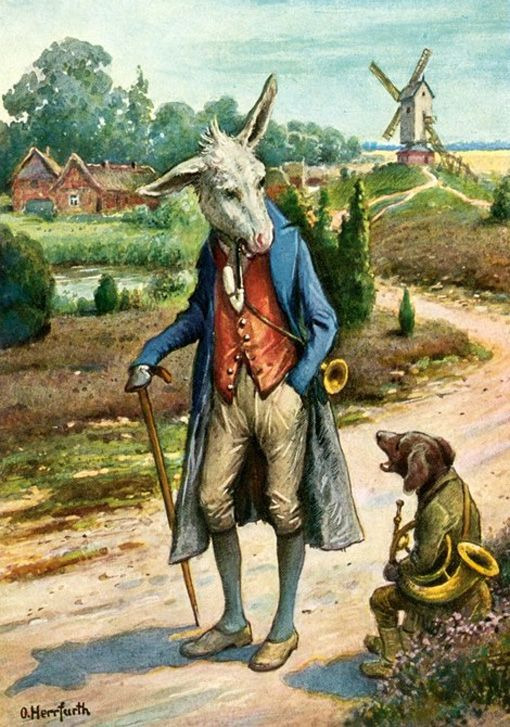
The Musicians of the Town of Bremen (De Bremer Stadtmusikanten)
They eblong to the AT type 130 "The animals find a house for the night", more specifically the AT 130 B, "The animals flee after a death threat".
This fairytale, like many of those present in the brothers Grimm collection, was actually the fusion of two distinct stories they collected. The brothers Grimm described in their notes a literary source for this story: a long extract from "Froschmeuseler", a didactic epic by Georg Rollenhagen published in 1595 and which had animals as protagonists. In this text however, it is a dog that leads the six other animals (an ox, a donkey, a cat, a rooster and a goose). For this poem (of 20 000 verses) Rollenhagen himself had another literary inspiration: a first-century epic describing a war between frogs and mice.
The nicknames of the various animals were only added in the third edition of the book. The notes of the brothers contain a third version of the tale they did not use, and which mostly differs when they arrive at the robbers' house. Instead of chasing them away, the animals enter peacefully in the robbers' den, play music and are fed as a reward. Then the robbers leave, and when they return they send one of theirs to check if everything is alright in the house - and he suffers the fate described in the Grimm's final tale. There are other versions of the story where there are only two animals involved (a dog and a rooster), who get involved with a fox that the dog ultimately kills. In fact, the oldest versions of this tale all deal with domestic animals confronting, not human criminals, but rather savage animals of the forest. Outside of Rollenhagen's text, another literary precedent was a poem of Hans Sachs from 1551, where the house is inhabited by wolves.
The title of this story seems to refer to traditional mockeries of the music of the town of Bremen, which was a very famous city at the time. Anti-Aarne wrote an entire monography about this tale-type, "The travelling animals" (Die Tiere auf der Wanderschaft) where he highlighted how this story was the Western "sibling" of a more Oriental fairytale-type, the AaTh 210 "The rooster, the chicken, the duck, the pin and the needle are travelling". This tale is mostly present in the Far-East (Middle-East?), and very rare in Western Europe - but it is still present within the brothers Grimm's collection as the KHM 10 (The Pack of Ragamuffins), 41 (Herr Korbes), and 80 (The Death of the Little Hen). The oldest Western form of this other fairytale type is within the Latin poem by Nivard of Gand, 1150's "Ysengrimus", where animals considered too old are banished by their masters or about to be killed, and flee into the forest. The "Roman de Renart" (the Roman of Reynard) also contains ths motif in its eighth branch - and the ingratitude of mankind towards the creatures that served them all their life is also a theme of the KHM 48 (Old Sultan).
#german fairytales#grimm fairytales#brothers grimm#the frog king#rapunzel#hansel and gretel#cinderella#history of fairytales#evolution of fairytales#the musicians of the town of bremen#little red riding hood#frau holle#the brave little tailor
19 notes
·
View notes
Text
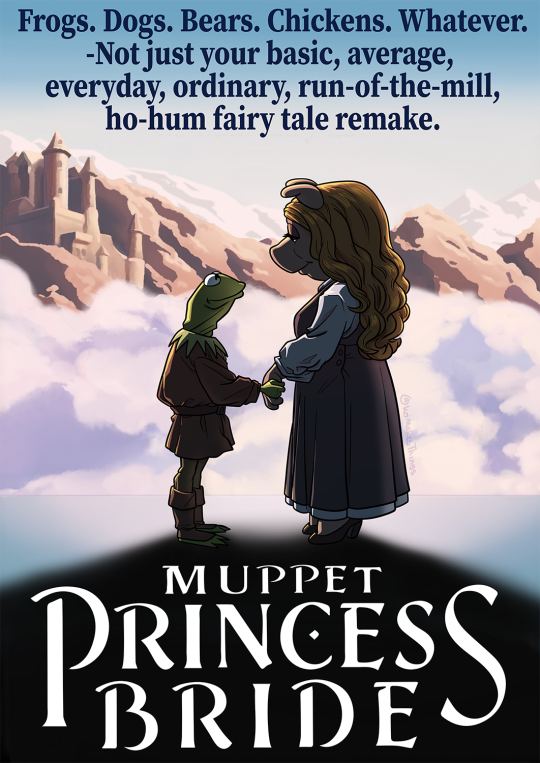
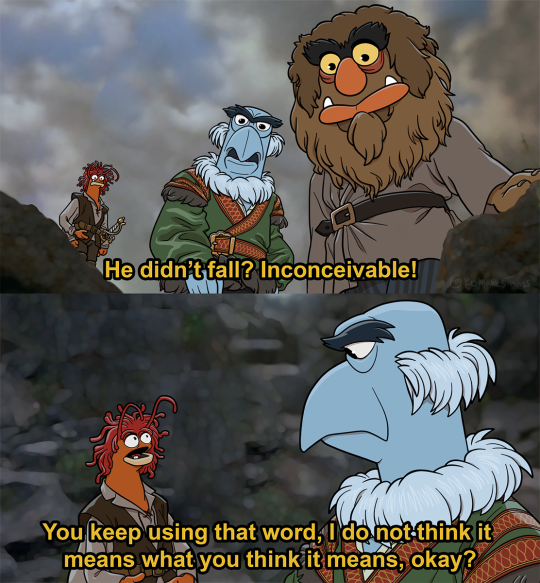
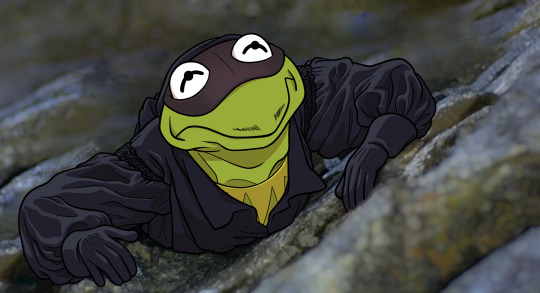

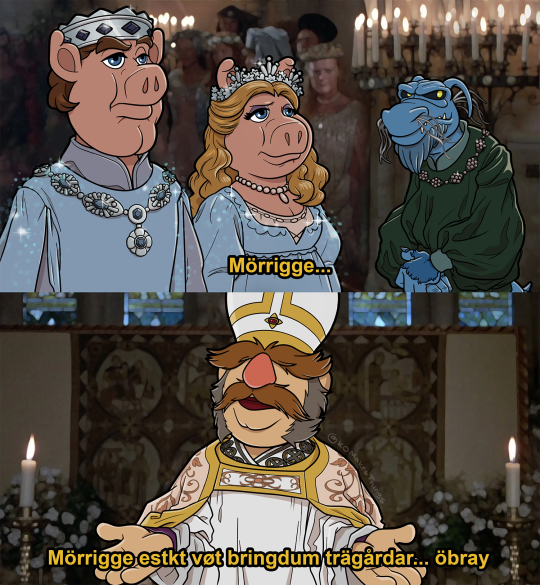
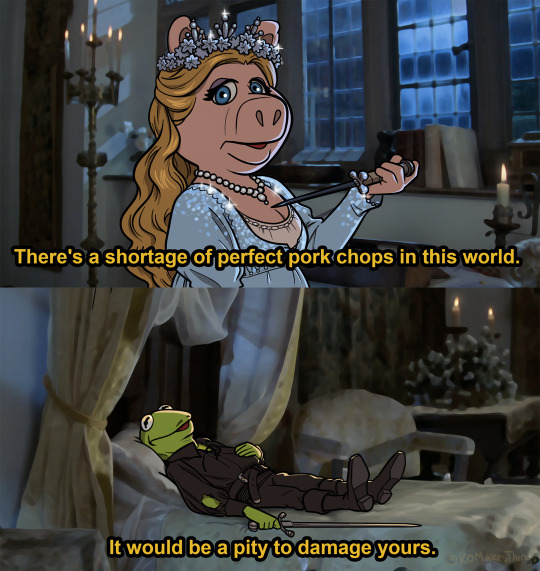
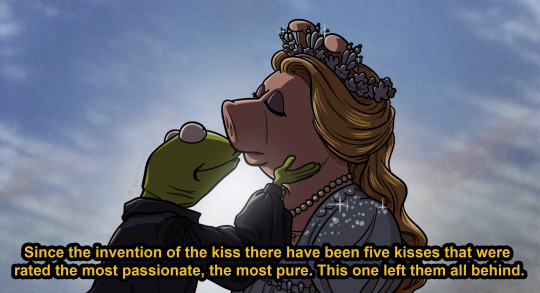

I've slowly been chipping away at drawing scenes from that imaginary Muppet retelling of the Princess Bride, figured it was about time to share what I've drawn on Tumblr!
#Muppet Princess Bride#princess bride#jim henson#kermit the frog#miss piggy#as you wish#the princess bride#cary elwes#robin the frog#sweetums#pepe the king prawn#sam the eagle#uncle deadly#link hogthrob#the muppets
92K notes
·
View notes
Text

Have you guys seen that clip
Go off Kermit
#the muppets#muppets#kermit the frog#this king is like ‘heterosexual? Never heard of her’#my art#mine
116K notes
·
View notes